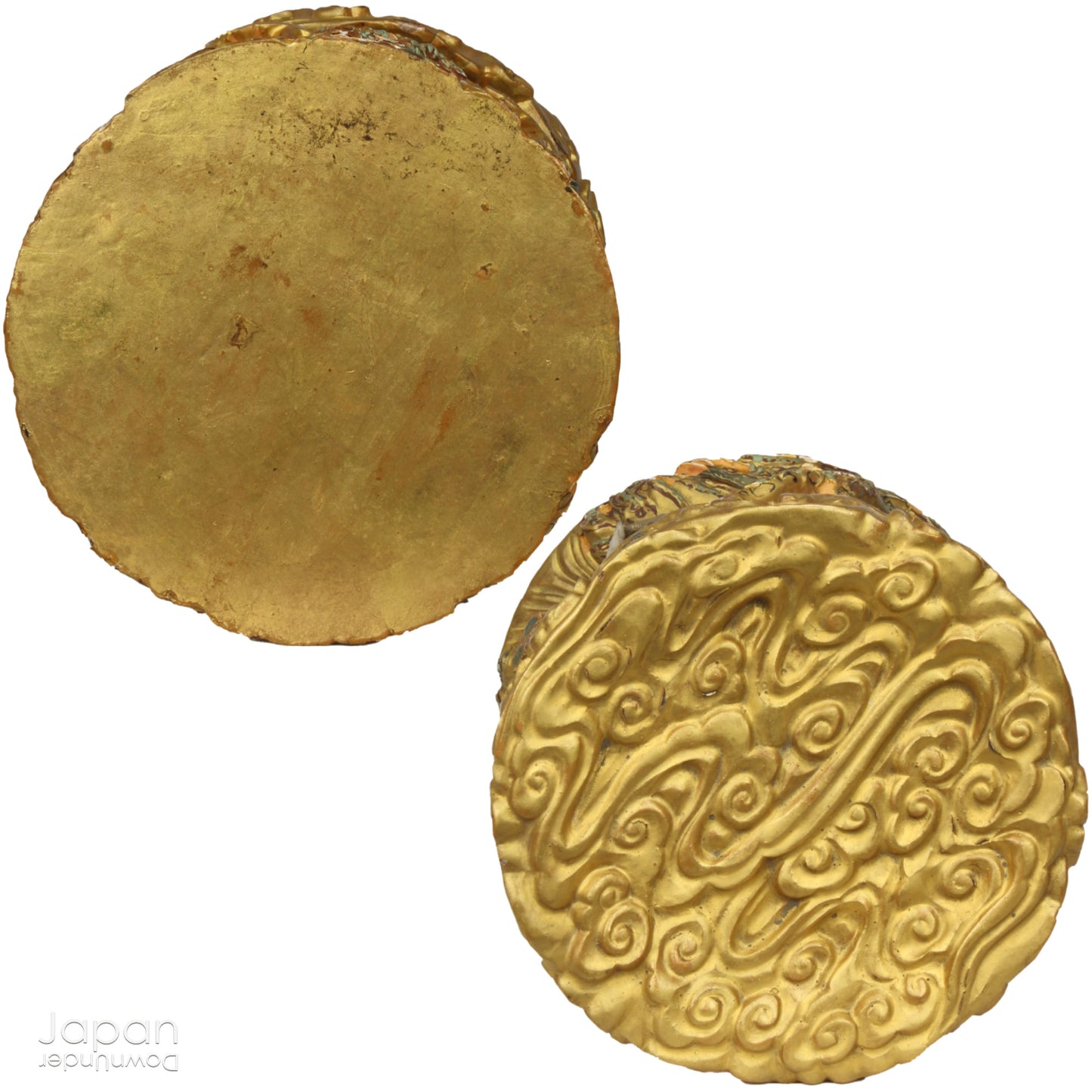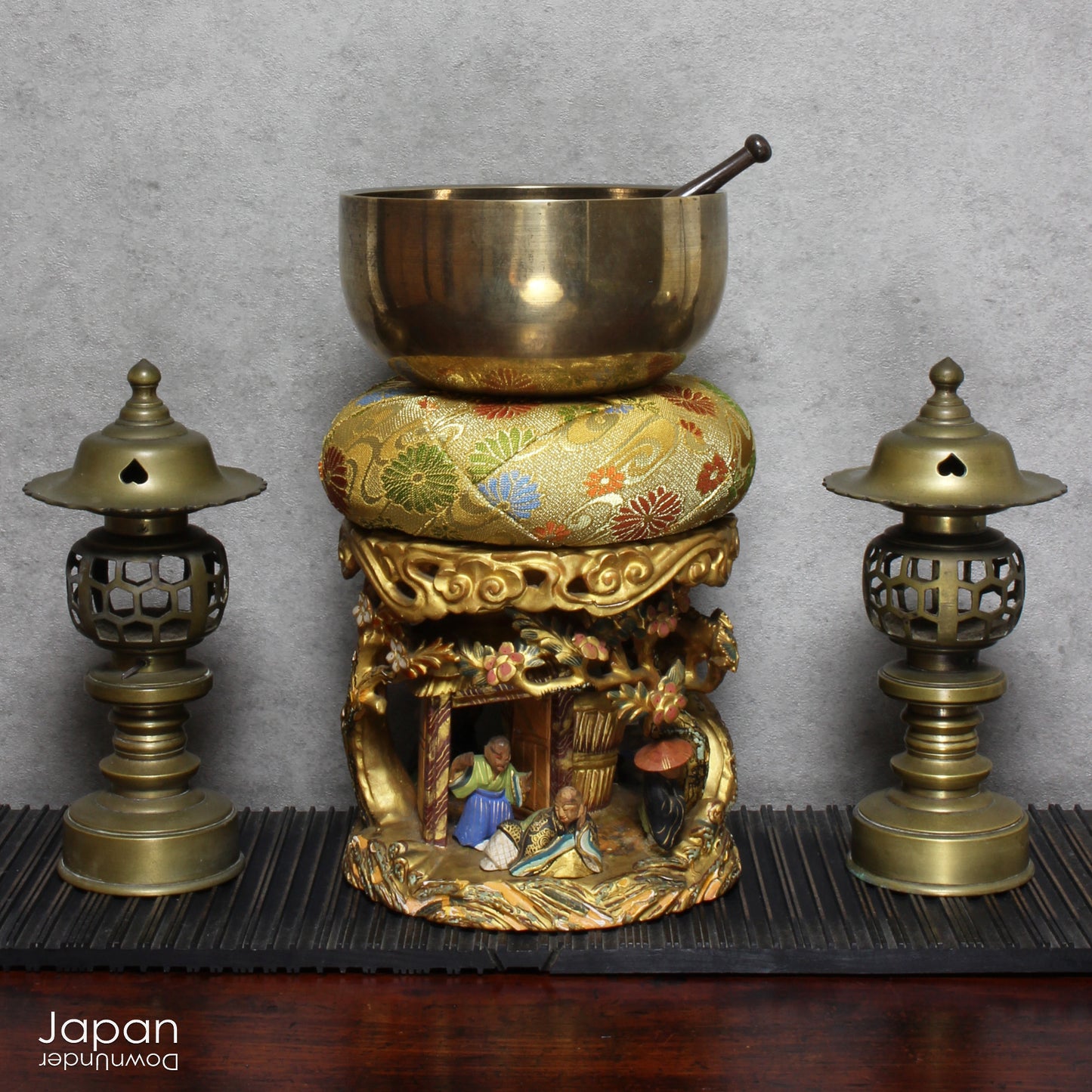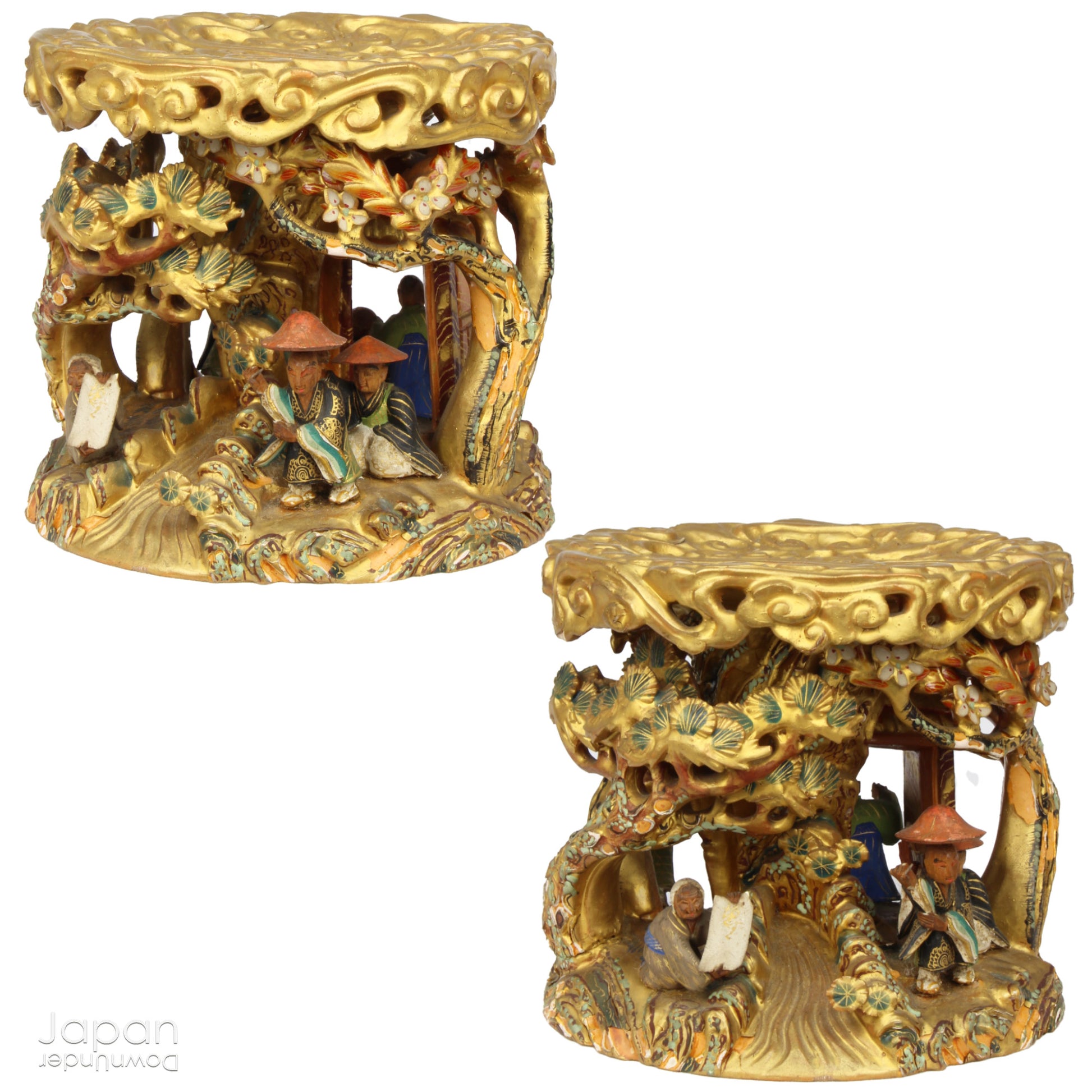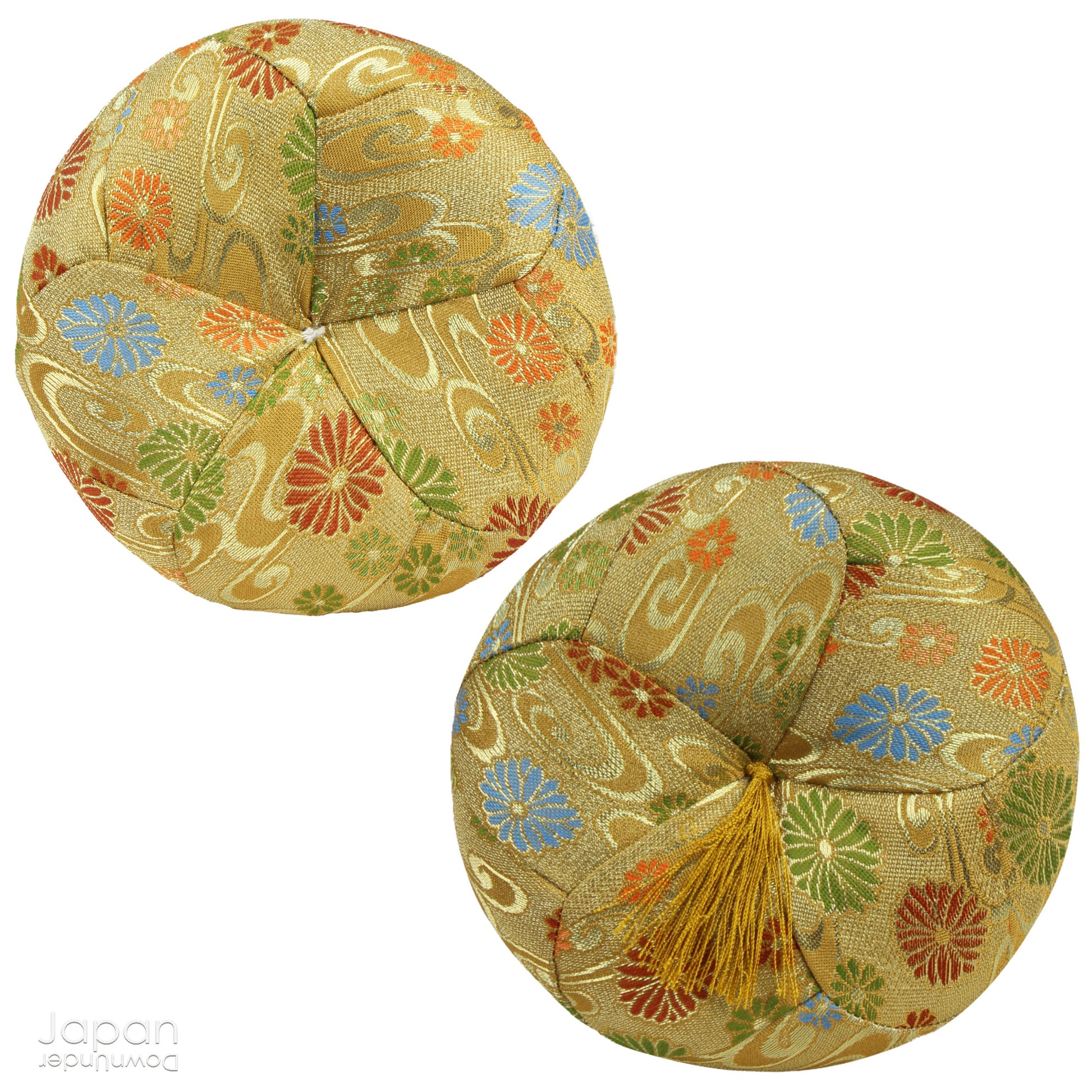JapanDownUnder
antique buddhist altar singing bowl on custom order carved stand with brocade cushion -one-of-a-kind buddhist art
antique buddhist altar singing bowl on custom order carved stand with brocade cushion -one-of-a-kind buddhist art
Couldn't load pickup availability
Love Japanese Style Like We Do
An 1800’s Buddhist altar singing bowl, harmoniously displayed on a traditional intricately carved custom order stand. Complete with a luxurious brocade cushion, this set exudes timeless elegance and spiritual significance. Add a touch of serenity to your space with this exquisite treasure!
During the Meiji Era (1868-1912) the Buddhist family altar (Butsudan) was a very important and very large piece of household furniture, hence the large size of this one-of-a-kind set.
At this time the Butsudan was a custom order piece of furniture, made by seven skilled craftsmen, with the parts finally being assembled by the Butsudan shop. Its appeal was in the elaborate carvings done by the chokokushi or carver, who was responsible for creating the transoms, other decorative parts, the Buddhist god and the accessories necessary for the butsudan. Customers made choices from designs handed down through generations of the carver’s family. The carvings could be left in the natural wood, gilded, or painted, by another artisan.
This orin stand was part of a Butsudan custom order. Impeccably carved, with intricate dimensions, it features a Chinese sage pattern, with each viewing angle telling a different story. The carving has been gilded, with selected areas tastefully painted in greens, deep reddish brown, grey, pink and blue tones. The small sage figures, interspersed amongst the maze-like chambers created by the twisted trunks and foliage of the pine and other trees, is truly wonderful. The top of the stand, where the cushion is placed, has a gilded swirling water and cloud pattern.
The brass orin is quite large and rings with a lovely high pitched, clear sound that resonates for quite some time. The striker is made of plain wood.
The floral gold silk brocade cushion, has blue and green accent colors echoing those of the painted images in stand, completing the piece with a good color balance. It is a sturdy cushion that supports the orin well.
The set is in good condition for its age. As is the case with old gilded pieces there are areas where the paint work is flaking. The stand needs to be treated gently and carefully. (There may be small specs of flaking during transit). The orin has darkened pitted marks on the inside and the outside is very beautiful. The wooden stiker has wear. The set comes in an old wooden box.
An exquisite piece of art that you will never see again and never tire of looking at!
- total height 26.5 cm (10.4”).
- orin measures 14.5 cm (5.7”) in diameter x 8 cm (3.1”) tall.
- cushion measures 16 cm (6.3”) in diameter x 6 cm (2.4”) tall.
- striker measures 13 cm (5.1”) long.
- total weight 1,800 gm.
(listing for boxed orin bowl, cushion, stand and striker)
SHIPPING INFORMATION
- please our shipping policy.
- we use recycle packaging and wrap for safety, rather than appearance.
ABOUT OUR VINTAGE, ANTIQUE AND OTHER ITEMS
We list pieces we feel are worthy of display. There may be scratches, dents, fading and signs of wear and tear. We try to explain the condition of each item exactly, but may miss something.
Information regarding the item and it’s age is obtained from dealers and our personal research. We do our best to give you the correct information but please be aware that we cannot guarantee this information.
Please message us prior to purchase with any questions you may have about our products.
THE BUTSUDAN
At the end of the Warring States period, Japan entered the long, peaceful centuries of the Edo period (1603-1868). Traditional craftsmen such as cabinet makers, lacquerware artists, and metallic ornament makers who had produced samurai swords, helmets and armor lost their jobs. They began using their master skills to make Buddhist altars, or Butsudan, for the home.
The practice of keeping a Butsudan supposedly began in the Kamakura Period (1185–1333), but it didn’t become popular until the Edo Period in the 17th century. When Christians were being persecuted in Japan, the butsudan is said to have spread among families who wanted to show that they were not Christian. Today, however, Japanese homes are not designed to accommodate this large piece of furniture, so fewer and fewer families use a butsudan.
Traditional butsudan are like miniature Buddhist temples in the home. People pray to deceased family members and ancestors in front of the Butsudan. Photos of the recently deceased along with small vertical tablets (ihai) inscribed with their names are placed in the butsudan along with various Buddhist implements such as candle holders, vases, rice and sake offering vessels, incense burner and orin bell. Attention is directed to the butsudan’s central figure, usually a Buddha statue or scroll. While praying in front of the butsudan, family members ‘talk’ or ‘report’ to the deceased about their lives and achievements. The butsudan unifies and bonds living family members as it reminds them of their common ancestors.
The traditional butsudan is a major assemblage of intricate, elaborate, and ornate artwork. There are at least seven types of highly skilled traditional craftsmen involved in making a butsudan: the cabinet maker (kiji-shi) who makes the wooden exterior cabinet, the inner altar builder (kuden-shi) who makes the butsudan’s inner sanctum complete with a temple-like roof, the woodcarver (chokoku-shi) who carves the transoms and Buddha statue, the lacquer painter (nuri-shi) who lacquers the cabinet, the gold leaf gilder (kinpaku-oshi-shi), the metallic ornament maker (kazari-kanagu-shi) who makes metallic fittings and ornaments, and the maki-e artist (makie-shi) who creates lacquer decorations with sprinkled gold powder. The butsudan parts are then sent to be assembled by the butsudan shop that received the customer’s order. The seven craftsmen, all working separately, never see the finished product.
The best traditional craftsmen are certified with the official title of ‘Traditional Craftsman’ from the Minister of Economy, Trade and Industry.
THE BUTSUDAN WOOD CARVER
Japanese master carvers (chokokushi) are renowned world wide for their high level of expertise, acquired over long years of training. Unfortunately carvers today are struggling to survive.
The chokokushi’s patterns are his special treasure, often having been in the family for several generations. Ultimately the customer chooses the pattern themes.
There are patterns like the ‘Chinese lion and peony’, ‘peonies with peacocks’, ‘paulownia with phoenix,’ ‘dragon with clouds and water,’ Buddhist wheels, stone footprints of Buddha, and sages. A special composite pattern called ‘Twenty-four Historical People’, selected in China for showing great filial piety, is very popular. Traditional religious patterns liked by the Japanese include ‘8 disciples’ or ‘16 disciples,’ ‘heavenly beings in the clouds’ and ‘Buddhist wheels in the clouds.’ Patterns that bring together seasonal elements of nature with musical instruments have a mystical feel. For those who don’t really care about religious symbolim, ‘deer and maple trees’ and ‘hanafuda cards’ may be requested. The simple peony flower is a favourite, along with ‘peonies in the wind.’
Because of the technical skill required, it can take as long as two months to measure-up, design and make these carvings.
Some of the many considerations for the master carver include:-
(1) the budget which dictates the intricacy and patterns.
(2) Coloring. Before being installed in the butsudan the carvings may be lacquered and gilded with either gold leaf, or gold powder, or colorfully painted. The choukokushi must keep in mind how much of the detail will be lost when these coatings are applied. Getting this just right is part of his special skill that only comes with years of experience. If the customer prefers natural wood, he takes into account the grain pattern on the wood when creating the subtle carving of the figures faces.
(3) Positioning. At the top of the butsudan, themes related to air, birds, clouds or heavenly beings are used. These would never be found around the base where water or ground topics prevail. In the middle of the butsudan, themes associated with either air or land and water. This part is at eye-level to the knelling supplicant, so the related carvings must be elegant, but not detract concentration on the focal point, the Buddhist image.
(3) Type of wood. The carver must choose the best wood with the best seasoning time to fit the customers requests. Three years is a minimum drying time, but often much longer is required. Many carvings are done with keyaki (zelkova). It is the most expensive wood. Hinoki is also used an it takes more time to carve because the grain is fine and dense, A well-sharpened, pointed blade, becomes dull and breaks easily, and so has to be sharpened even more often than with other woods. Hinoki carvings command a high price, but as the grain is dense it lasts a long time. Houryuuji temple is made of hinoki and it has lasted more than 1000 years!
(4) Tools. The chisel is a choukokushi’s basic implement. The blades are selected depending on the depth and shape of groove required. They can be made by the artist or ordered. A favourite, much used tool, might last 20 years.
Share




















